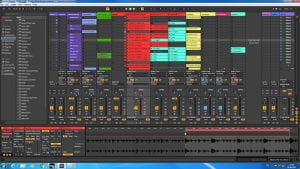See previous posts about the lockdown that occurred in spring 2020 and how I used the time spent at home to study Ableton Live 10 at a well known music education institution. Below are my comments on assignment 8, which asked us to remix on the basis of using vocal stems. We were free to use whatever tools afforded by Ableton and of musical references for the new musical context. I decided to use samples off music by Medeski, Martin & Woods exclusively.
The overall idea of my remix, is to fuse samples of the funky jazz trio Medeski, Martin & Wood with the rhytmical hip hop vocals of the tune Never met before. I spent a lot of time sampling sections of various tunes directly from Spotify and routed into Ableton. The music came in various tempo and pitches, so I had to compromise to make all the samples fit harmonically and tempo wise. I transposed the vocal stem up 1 semitone to Db. Then I could pitch the jazz material 2 semitons at the most to keep it in harmony. I found an algorithm, Tones, that smoothed out the sound of the samples that had to change most radically to fit the new tempo. Mainly I decided on where 1.1.1 is, and asked Ableton to warp from here. I did not have to add further warp marks to make the loops fit. I faced a challenge since some of my recorded samples featured both bass and drums, others only bass or drums. I inserted compressors and EQ8s to try to control the levels and frequencies of the various samples. Eventually, I inserted the Ozone master plugin, which I assume overrides and compensates for some of what I missed in my mix. I selected the preset Stereo Bus Energy that is a Mid channel EQ “to bring out the vocals and energize your mix”. It high shelves the bass frequencies, softens the mid range, and boosts the above 4 khz. Working on the vocals, I routed the vocals through a vocoder and every time I played the sound of the carrier (Arena brass) on my MIDI keyboard, it would generate vocoded harmonies in a separate track. I automated sends to the Delay channel where I unlinked L & R and used a setting of 20ms and 100 ms to make a sense of space. A section of the female voice part was chopped up and assigned to pads in a Drum rack for midi recording. I did not listen to the original until I had completed my work, and got really surprised by how far off I went.

